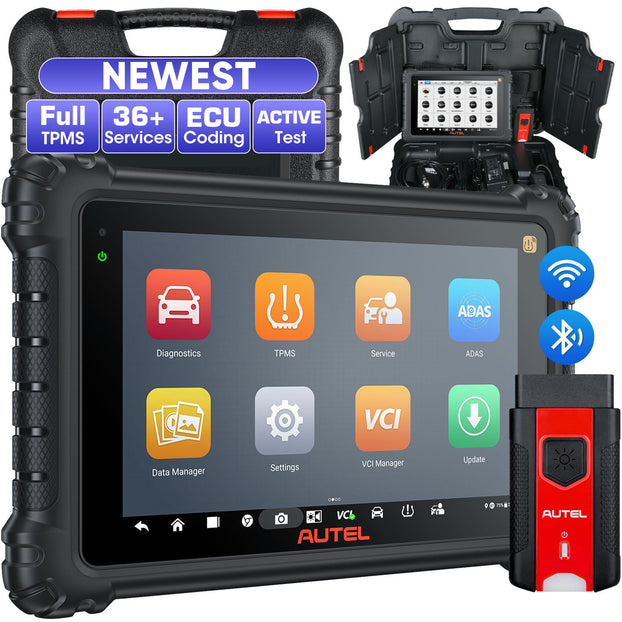What does TPMS Mean on a Car?
What dose TPMS Mean
TPMS is the abbreviation of Tire Pressure Monitoring System.A Tire Pressure Monitoring System (TPMS) is a critical vehicle safety feature that continuously tracks air pressure levels in pneumatic tires. This system alerts drivers through:
- Real-time pressure displays (digital gauges or pictograms)
- Warning lights (when pressure drops below safe levels)
Two TPMS Technologies
1.Direct TPMS (dTPMS)
- Uses physical sensors inside each tire
- Provides precise, tire-specific pressure readings
2.Indirect TPMS (iTPMS)
- Relies on wheel speed sensors (ABS/ESC systems)
- Calculates pressure changes through rotation differences
At present, direct TPMS is the mainstream
How direct TPMS works
A pressure sensor is installed in the tire to directly measure the tire's air pressure and temperature, and a wireless transmitter is used to send the information from inside the tire to the on-board system, and then the display shows the air pressure data of each tire.
Pros and Cons of dTPMS and iTPMS
1.Pros and Cons of dTPMS
|
Pros
|
Cons
|
|
Timely feedback
|
More expensive overall than an indirect TPMS
|
|
The tire pressure data measured is more accurate
|
Proprietary systems confuse consumers and shops.
|
|
Battery lasts about a decade
|
Non-Serviceable battery requires full sensor replacement"
|
2.Pros and Cons of iTPMS
|
Pros
|
Cons
|
|
Relatively inexpensive compared to a direct TPMS
|
Inaccurate data collection
|
|
Lower programming and maintenance needs than direct TPMS
|
Has a certain hysteresis
|
What is a Tire Pressure Monitoring System Tool?
A TPMS diagnostic tool is a specialized device designed to read and troubleshoot issues in a vehicle's Tire Pressure Monitoring System. It enables users to inspect tire pressure sensors, monitor real-time tire pressure levels, and reset the TPMS warning indicator on the dashboard.
Modern TPMS scanners come in various forms, and technological advancements have transformed them from large, complicated units into compact, user-friendly handheld devices.
Why You Need a TPMS Tool:5 Critical Reasons
- Reason 1:Prevent Unsafe Driving Conditions
The tire pressure monitoring system can detect tire pressure values in real time.When the tire pressure is too low, the friction between the tire and the ground increases, causing the temperature to rise and potentially leading to tire blowouts.
The TPMS tool can detect a decrease in air pressure and promptly handle it to avoid sudden tire blowouts during high-speed driving, thereby reducing the occurrence of traffic accidents
- Reason 2:Reduce maintenance costs
Underinflated tires not only wear out more quickly, but they also increase the risk of damage to other crucial vehicle components, such as the wheels, suspension, and steering system. When tires are underinflated, they don't make proper contact with the road, causing uneven wear and placing excessive stress on the vehicle's suspension, which can lead to costly repairs.
By using a TPMS tool for early detection, you can identify low tire pressure before it becomes a major problem. This proactive approach helps you avoid premature tire replacements, extend the lifespan of your tires, and protect other expensive vehicle parts from damage, ultimately saving you money in the long run.
- Reason 3:Reset TPMS Warning Lights
After inflating tires to the correct pressure or replacing faulty TPMS sensors, it's not uncommon for the dashboard warning light to remain illuminated. This occurs because the TPMS system needs to be reset in order to recognize the updated tire pressures or newly installed sensors.
The TPMS fault light on the car dashboard
A TPMS tool is essential in this case—it allows you to quickly and easily reset the system, ensuring that the warning light goes off and that the system is properly calibrated. This means you can avoid the hassle of scheduling a trip to the mechanic for something that could be done in minutes, saving both time and money while keeping your dashboard clear of unnecessary alerts.
- Reason 4:Check Sensor Health
A failing TPMS sensor doesn't always stop working immediately—it often starts sending inaccurate or intermittent readings, which can mislead you into ignoring real tire pressure issues. A TPMS scanner actively checks each sensor's health, detecting:weak or dying batteries,signal transmission errors and malfunctioning valves or corrosion.
By diagnosing these issues early, you can replace failing sensors before they leave you unprotected.
- Reason 5:Extend the life of your tires
Car tires are like the "feet" of a vehicle, and their tire pressure directly affects driving safety and tire lifespan. The Tire Pressure Monitoring System (TPMS) tool is an "intelligent steward" that safeguards tire health.
With the assistance of TPMS tools, car owners can adjust tire pressure in a timely manner to keep tires in the best working condition. This not only significantly improves stability and safety during driving, but also maximizes the service life of tires, reduces the frequency and cost of tire replacement, and truly achieves a dual guarantee of economy and safety.
TPMS Tool Recommendations
Autel TPMS sensors

Autel MX-Sensor
There are three models of Autel MX Sensor, namely MX Sensor (rubber version), MX Sensor (metal version), and MX Sensor (BLE-A001)
MX Sensor (rubber version) and MX Sensor (metal version) differ in the material of the press in valve stem, but are consistent in other aspects. They have a combination frequency of 315MHz and 433MHz and can be programmed using the Autel TPMS service tool. They are 99% compatible with original sensors
MX Sensor (BLE-A001) is a pre-programmed Bluetooth Low Energy (BLE) sensor that offers “fit & go” capability for Tesla 3/Y/S/X models. Built to meet or exceed industry standards and tested to endure extreme temperatures, the MX-Sensor BLE is also programmable with Autel tools for the latest BLE-equipped vehicles.
Autel TPMS diagnostic scanner

AUTEL MaxiTPMS TS508WF
Autel MaxiTPMS TS508WF is Autel's first non-tablet tool providing Wi-Fi software updates.This TPMS service tool is a comprehensive solution for tire pressure management, offering the ability to read, activate, and relearn all recognized sensors. It features dual MX-Sensor programming techniques, allowing for versatile and efficient setup.
Additionally, it enables placard value resets on compatible vehicles, ensuring accurate pressure readings. Both the TS508WF and TS508 models provide on - tool guidance for MX-Sensor relearning through OBDII and other methods.
They also support key fob signal testing, providing a complete diagnostic and maintenance experience for tire pressure monitoring systems.
- Autel MaxiTPMS ITS600 (E)

Autel MaxiTPMS ITS600
Autel MaxiTPMS ITS600 is a wireless,5.5-inch touchscreen Android-based TPMS diagnostics and service scanner.It offers a full suite of essential diagnostic capabilities, including sensor programming, relearning, activation, and reading, ensuring accurate and efficient tire pressure management.
Additionally, it incorporates user-friendly tire- related features, such as a VINscan function for rapid vehicle identification, TPMS module retrofitting options,and four common maintenance services.
- Autel Maxisys MS906Pro-TS
The Autel MaxiSys MS906 Pro-ts is an advanced wireless OBD2 scanner in the MaxiSys series. In addition to basic diagnostic functionsit ,it offers comprehensive TPMS services, including sensor diagnosis and programming.It covers a wide range of vehicles and is suitable for testing all systems.
It also has superior special functions, including oil zeroing, EPB (electronic parking brake), SAS (steering angle sensor), BMS (battery management system), etc. It can fully meet the needs of almost all automotive diagnostic work except TPMS.
Here you can check more Autel TPMS Tool










Leave a comment